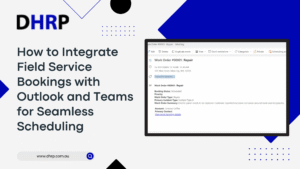Deferral schedules have been helping enterprise users of Dynamics 365 Finance for some years now. They ensure the streamlining of recurrent billing, subscriptions, prepaid services, and large-scale projects.
Moreover, complying with worldwide standards has never been easy. Whether you’re following IFRS 15 or ASC 606, you can always stay on top of compliance.
With time, Microsoft has significantly improved D365 Finance’s deferral schedules in the 2024-25 release. As a business specialising in Dynamics 365 Finance implementations across multiple industries, these upgrades are a significant step toward more innovative, more compliant, and user-centric financial operations.
Our previous blogs explored what’s new in Dynamics 365 Finance Release Wave 1 – 2025 and Dynamics 365 Finance 10.0.41. We also covered how Dynamics 365 Finance Copilot is reshaping automation in modern finance management and what XDS Security Roles mean for financial data security in D365.
Today, the focus shifts to another critical area—the enhancements to deferral schedules in the 2024–25 release. Let’s explore the updates in more detail.
New Updates: What’s new in Deferral Schedules in Dynamics 365 Finance 2024 Update
While you manage other aspects of business, AI and automation in deferral schedules do all the legwork. So, what are teh new features to help you? Let’s learn more about it.
1. AI-Driven Deferral Management in D365 Finance
AI is everywhere, so how could deferrals not be managed with it? We don’t see any reason why not. Therefore. Microsoft has incorporated AI-powered intelligence into deferral processing. It tracks and saves your data. Then, based on historical data patterns, the technology now automatically offers suitable deferral timings.
- So, if you consistently record license money over a 12-month period, the system will recommend that you plan the next time you conduct a comparable transaction.
- It can also alert you about any unexpected deferral periods that are different from the standard. So, before the problem strikes, you and your team can identify the issue and resolve it as soon as possible.
Sounds like everything will change? YES.
D365 Finance’s AI-Driven Deferral Management lowers the manual labour necessary to create deferral entries while increasing accuracy and compliance.
2. Time-Saving Automation in Deferral Processing
This update in Dynamics 365 Finance deferral schedules focuses mostly on efficiency. The system now adds intelligent defaults and automated capabilities to reduce friction in recurrent postings.
- You may now set deferral defaults at the customer, product, and transaction levels.
- Schedules are generated automatically based on invoice line details and rule configurations.
- Periodic recognition is totally automated and coordinated with your deferral schedule (monthly, quarterly, or customised).
This is especially useful in high-volume businesses like SaaS and managed services, where hundreds of revenue recognition entries must be issued regularly. These D365 revenue deferral innovations dramatically reduce closing timeframes and manual reconciliation requirements.
3. Enhanced Visibility and Financial Reporting
Historically, visibility into deferred and recognised revenue required manual exports or Power BI adaptations. That has changed in this release.
- New reporting grids provide real-time recognition schedules and amounts within Dynamics 365 Finance's deferral schedules forms.
- Drill-down dashboards enable financial teams to filter results by client, project, or product.
- With native Power BI integration, you can incorporate deferred revenue data into executive dashboards without the need for additional data models.
- Adjustments made in the middle of the schedule (for example, contract updates) are now incorporated promptly, increasing forecasting dependability.
For CFOs and FP&A teams, this increased insight clarifies one of finance’s most difficult areas, and it complements long-term strategy planning.
4. UI and Workflow Updates for Better Usability
Microsoft continues to improve the user experience in D365 Finance. And this release includes improved procedures for setting up and managing deferrals.
- The deferral schedule configuration page now has inline tooltips, conditional fields, and error validation.
- Workspaces are role-optimised. Accountants only see the configurations they need, whereas controllers can overturn regulations and approvals.
- Bulk editing and scheduling reassignment features have been added, which are very beneficial for mergers or restructured GL accounts.
These usability enhancements enable finance teams to adopt and manage sophisticated deferral logic with minimal training.
Real-World Use Cases Across Industries
These enhancements in D365 Finance are not just theoretical — they’re already delivering tangible results across various sectors:
- Software licensing: By using automated schedule generation and AI-suggested templates, a SaaS company with thousands of monthly users cut monthly closing time by 40%.
- Prepaid Services: A facilities management company implemented batch deferral automation for multi-year prepaid contracts, which improved compliance and reduced mistake rates.
- CapEx Projects: A construction firm now tracks recognition across project phases, using Power BI dashboards to show how delayed revenue correlates with project milestones.
Such cases demonstrate the upgraded features’ adaptability and robustness, regardless of industry.
How to Set Up Deferral Schedules in Dynamics 365 (2024 Guide)
Don’t know how to set up? Here is a simple way that you might need to do it in detail:
- Go to the Feature Management workspace and enable the Subscription Billing module as well as Revenue and Expense Deferrals.
- It is important to note that this functionality cannot coexist with the earlier Revenue Recognition module; only one can be active at any given moment.
- Check that your user role has permissions to view deferral settings.
With the above steps, you’ll ensure a smooth transition and see instant benefits from the additional features too. So, let’s get started?
But How to Get Started?
Once you define automatic rules for deferral recognition based on customers, items, or transaction types, the rest is just to use the features:
- Update or Create Deferral Templates:
Configure templates with recognition methods (e.g., straight-line) that align with IFRS 15 or ASC 606.
- Activate and Test AI Suggestions:
Enable AI-driven deferral recommendations and validate them on sample entries for accuracy.
- Train Your Finance Team:
Highlight UI changes like bulk editing, inline validation, and easier schedule tracking.
- Use Reporting Tools and Dashboards:
Connect Power BI to view deferral vs. recognised revenue, trend analysis, and schedule health.
- Schedule Periodic Reviews:
Run monthly checks using new reports to ensure compliance and spot anomalies early.
Conclusion
In conclusion, the D365 deferral schedule enhancements and D365 revenue deferral enhancements introduced in the 2024–25 update bring powerful improvements in automation, AI-driven insights, and financial reporting. These features not only streamline deferral processes but also improve accuracy, compliance, and usability across industries.
Whether you’re handling SaaS subscriptions, prepaid contracts, or large CapEx projects, these updates make revenue recognition more transparent and efficient. As a leading Microsoft partner, DHRP helps businesses implement and maximise these new Dynamics 365 Finance and Operations features to support smarter, more agile financial operations. Ready to take advantage of these enhancements?
Let DHRP guide your journey. Book a FREE demo now.



































































































